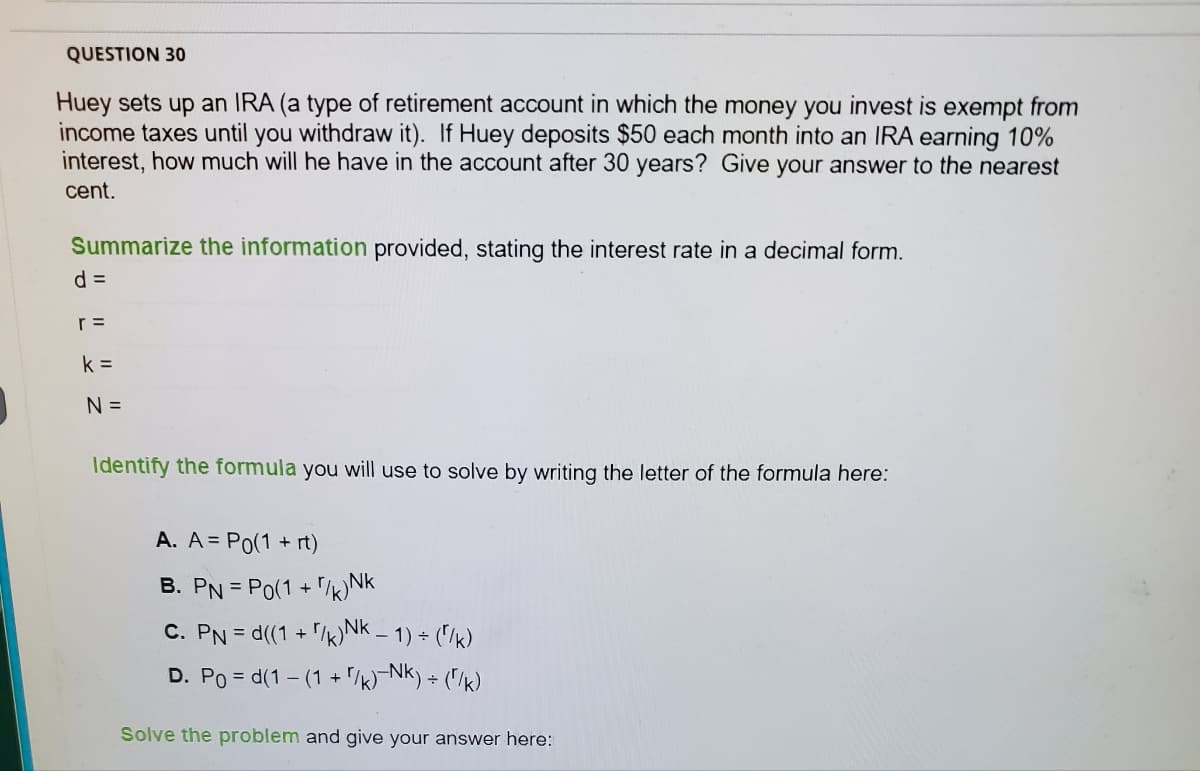QUESTION 30 Huey sets up an IRA (a type of retirement account in which the money you invest is exempt from income taxes until you withdraw it). If Huey deposits $50 each month into an IRA earning 10% interest, how much will he have in the account after 30 years? Give your answer to the nearest cent. Summarize the information provided, stating the interest rate in a decimal form. d D r = k = N = Identify the formula you will use to solve by writing the letter of the formula here: A. A = Po(1 + rt) B. PN = Po(1 + /k)NK C. PN = d((1 + /k) NK – 1) + ("/k) D. Po = d(1- (1 + "/k Nk) + ("Ik) Solve the problem and give your answer here:
QUESTION 30 Huey sets up an IRA (a type of retirement account in which the money you invest is exempt from income taxes until you withdraw it). If Huey deposits $50 each month into an IRA earning 10% interest, how much will he have in the account after 30 years? Give your answer to the nearest cent. Summarize the information provided, stating the interest rate in a decimal form. d D r = k = N = Identify the formula you will use to solve by writing the letter of the formula here: A. A = Po(1 + rt) B. PN = Po(1 + /k)NK C. PN = d((1 + /k) NK – 1) + ("/k) D. Po = d(1- (1 + "/k Nk) + ("Ik) Solve the problem and give your answer here:
Algebra & Trigonometry with Analytic Geometry
13th Edition
ISBN:9781133382119
Author:Swokowski
Publisher:Swokowski
Chapter5: Inverse, Exponential, And Logarithmic Functions
Section5.3: The Natural Exponential Function
Problem 38E
Related questions
Question

Transcribed Image Text:QUESTION 30
Huey sets up an IRA (a type of retirement account in which the money you invest is exempt from
income taxes until you withdraw it). If Huey deposits $50 each month into an IRA earning 10%
interest, how much will he have in the account after 30 years? Give your answer to the nearest
cent.
Summarize the information provided, stating the interest rate in a decimal form.
d =
r =
k =
N =
Identify the formula you will use to solve by writing the letter of the formula here:
A. A = Po(1 + rt)
B. PN = Po(1 +
NK
C. PN = d((1 + /k) NK – 1) + ("/k)
D. Po = d(1 - (1 + /k)¬Nk) + ("/k)
Solve the problem and give your answer here:
Expert Solution
This question has been solved!
Explore an expertly crafted, step-by-step solution for a thorough understanding of key concepts.
Step by step
Solved in 3 steps with 1 images

Recommended textbooks for you

Algebra & Trigonometry with Analytic Geometry
Algebra
ISBN:
9781133382119
Author:
Swokowski
Publisher:
Cengage

Algebra and Trigonometry (MindTap Course List)
Algebra
ISBN:
9781305071742
Author:
James Stewart, Lothar Redlin, Saleem Watson
Publisher:
Cengage Learning


Algebra & Trigonometry with Analytic Geometry
Algebra
ISBN:
9781133382119
Author:
Swokowski
Publisher:
Cengage

Algebra and Trigonometry (MindTap Course List)
Algebra
ISBN:
9781305071742
Author:
James Stewart, Lothar Redlin, Saleem Watson
Publisher:
Cengage Learning


College Algebra
Algebra
ISBN:
9781305115545
Author:
James Stewart, Lothar Redlin, Saleem Watson
Publisher:
Cengage Learning